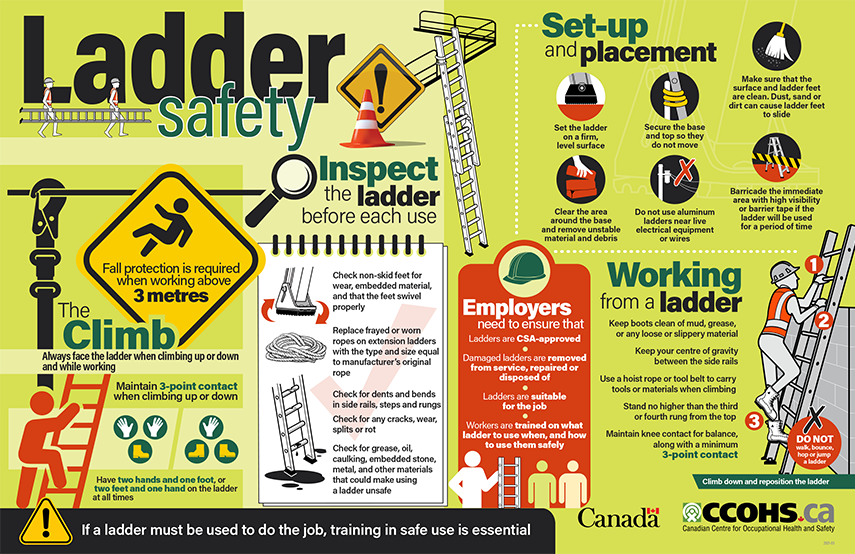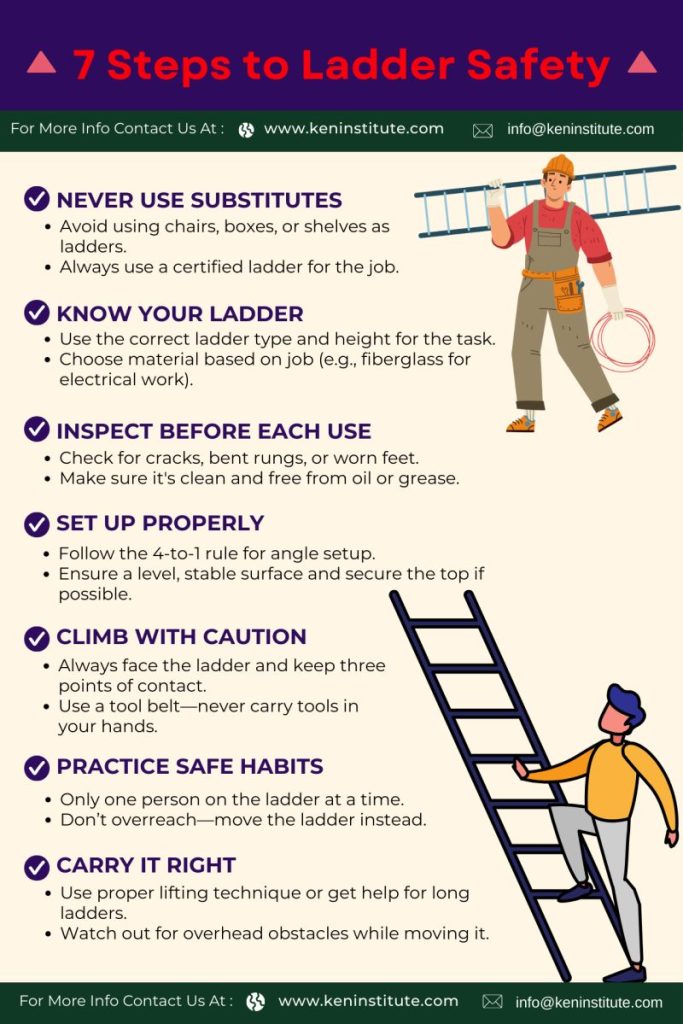Are you confident that you’re using your ladder safely every time? A simple misstep can lead to serious injury, but with the right know-how, you can protect yourself and those around you.
Understanding the 5 essential steps to ladder safety will give you the power to avoid accidents and work with peace of mind. Keep reading to discover these crucial tips that could save your life—and make your tasks easier and safer than ever before.
Choosing The Right Ladder
Choosing the right ladder is crucial for safe and efficient work. A proper ladder fits the task and keeps you secure. Picking the wrong ladder can cause accidents and injuries. Consider the job, height, and environment before selecting a ladder.
Types Of Ladders
Different ladders serve different purposes. Step ladders are great for indoor tasks and low heights. Extension ladders reach higher places and work well outside. Folding ladders offer portability and compact storage. Choose a type that matches your work needs.
Weight Capacity
Every ladder has a weight limit. This includes your body weight plus any tools or materials. Check the ladder’s rating before use. Using a ladder with insufficient capacity risks collapse. Select one that supports at least 25% more than your total load.
Material Considerations
Ladders come in aluminum, fiberglass, and wood. Aluminum ladders are lightweight but conduct electricity. Fiberglass ladders are heavier but safe near power lines. Wooden ladders are sturdy but need regular care. Pick a material based on your work environment and safety needs.

Credit: www.ccohs.ca
Inspecting The Ladder
Inspecting the ladder is a crucial step before any use. It helps prevent accidents and injuries. A thorough inspection ensures the ladder is safe and ready to work. Taking time to check the ladder increases overall safety on the job.
Checking For Damage
Look closely at every part of the ladder. Inspect for cracks, dents, or bends in the frame. Check the rungs and side rails for signs of wear or damage. Broken or bent parts weaken the ladder’s strength. Replace or repair damaged ladders before use.
Verifying Stability
Set the ladder on a flat, solid surface. Press down gently to test for wobbling. Make sure all feet are firmly touching the ground. Check that locks and hinges work properly and hold tight. A stable ladder prevents falls and improves balance.
Ensuring Cleanliness
Remove dirt, grease, or mud from the ladder. Clean rungs and rails to avoid slipping hazards. Clear any debris that may affect ladder placement. A clean ladder offers better grip and safer climbing. Regular cleaning helps maintain the ladder’s condition over time.
Setting Up Safely
Setting up a ladder safely is crucial to prevent accidents and injuries. A poorly positioned ladder can lead to falls or damage. Follow these simple guidelines to ensure a stable and secure setup every time.
Selecting A Level Surface
Always place the ladder on a flat, stable surface. Uneven ground can cause wobbling and instability. For soft surfaces, use a ladder with wide feet or stabilizers. Avoid slippery areas like wet grass, loose gravel, or polished floors.
Proper Angle Placement
Position the ladder at the right angle to ensure safety. The standard rule is a 4:1 ratio. For every four feet of ladder height, place its base one foot away from the wall. Use built-in angle indicators if available.
Securing The Ladder
Secure the ladder at the top and bottom to prevent movement. Use ropes, brackets, or ladder stabilizers to anchor it firmly. Ensure the locking mechanisms are fully engaged before climbing. Avoid leaning the ladder on unstable surfaces.

Credit: www.kiwa.com
Climbing And Working Safely
Climbing and working safely on a ladder may seem straightforward, but even small mistakes can lead to serious injuries. Whether you’re fixing a lightbulb or painting a wall, adopting the right practices ensures you stay safe. Let’s dive into three essential habits that can make a big difference when you’re up on a ladder.
Maintaining Three Points Of Contact
Always keep two hands and one foot, or two feet and one hand, in contact with the ladder at all times. This provides better stability and helps you maintain balance. For instance, if you’re carrying tools, use a tool belt instead of holding items in your hands to ensure your grip stays secure.
Avoiding Overreaching
It’s tempting to stretch a little further to finish the task, but overreaching is a leading cause of ladder accidents. Keep your belt buckle or body centered between the rails of the ladder. If you can’t reach something comfortably, climb down and reposition the ladder—it’s faster and much safer in the long run.
Using Tools Properly
Improper use of tools on a ladder can quickly turn dangerous. Use a hook, bucket, or tool belt to keep your tools handy without sacrificing stability. For heavier tools, consider asking for assistance to avoid unnecessary strain or imbalance while climbing.
By practicing these steps, you make climbing and working on a ladder not only safer but also more efficient. So next time you’re on a ladder, ask yourself: are you following these habits to ensure your safety?
Storing And Maintaining The Ladder
Properly storing and maintaining your ladder is essential for safety and longevity. Neglecting these tasks can lead to accidents or costly replacements. Taking a few simple steps ensures your ladder remains reliable every time you need it.
Cleaning After Use
Dirt, paint, and moisture can damage your ladder over time. After each use, wipe down the ladder with a damp cloth to remove any residue. Pay special attention to the rungs and joints where grime can build up and cause slipping hazards.
If you’ve been working with chemicals or paint, use mild soap and water to clean the ladder thoroughly. Avoid harsh solvents that might weaken the material. A clean ladder not only looks better but also performs safer.
Safe Storage Practices
Where you store your ladder affects its condition and your safety. Keep your ladder indoors or under a covered area to protect it from weather damage like rust or warping. Avoid placing it directly on the ground where moisture can accumulate.
Store the ladder horizontally on hooks or racks designed to support its weight evenly. If space is tight, standing it vertically against a wall with secure straps works too. Have you checked if your storage spot keeps your ladder out of reach of children or pets?
Regular Maintenance Checks
Inspect your ladder regularly to catch any problems early. Look for cracks, bends, loose screws, or worn feet before each use. Replace any damaged parts immediately to prevent accidents.
Lubricate hinges and locks to keep them working smoothly. Testing your ladder’s stability before climbing can save you from falls and injuries. How often do you review your ladder’s condition? Make it a habit to ensure your safety every time.

Credit: www.linkedin.com
Frequently Asked Questions
What Are The 5 Steps For Ladder Safety?
The 5 steps for ladder safety include inspecting the ladder, positioning it correctly, maintaining three points of contact, using proper footwear, and avoiding overreaching. Following these steps ensures safe ladder usage and minimizes risks of falls or injuries. Always prioritize safety when using ladders in any environment.
How Should I Inspect A Ladder Before Use?
Inspect the ladder for cracks, loose parts, or damage. Check stability, cleanliness, and ensure all locking mechanisms work. Never use a damaged ladder. Regular inspection prevents accidents and ensures the ladder is fit for safe usage, especially in professional or home settings.
Why Is Ladder Positioning Important For Safety?
Proper ladder positioning prevents slipping and instability. Ensure a firm, level base and follow the 4:1 rule: 1-foot base distance for every 4 feet height. Correct positioning reduces the risk of falls and ensures safe and effective ladder operation.
What Is The Three Points Of Contact Rule?
The three points of contact rule means maintaining two hands and one foot, or two feet and one hand, on the ladder. This ensures stability and reduces the likelihood of accidents. Always adhere to this rule for safe ladder climbing.
Conclusion
Following the five steps to ladder safety protects you from falls and injuries. Always check your ladder before use. Place it on stable, flat ground. Climb carefully, keeping three points of contact. Never overreach or carry heavy items while climbing.
These simple actions keep you safe every time. Stay alert and respect ladder rules. Safety first—it’s worth the effort.








